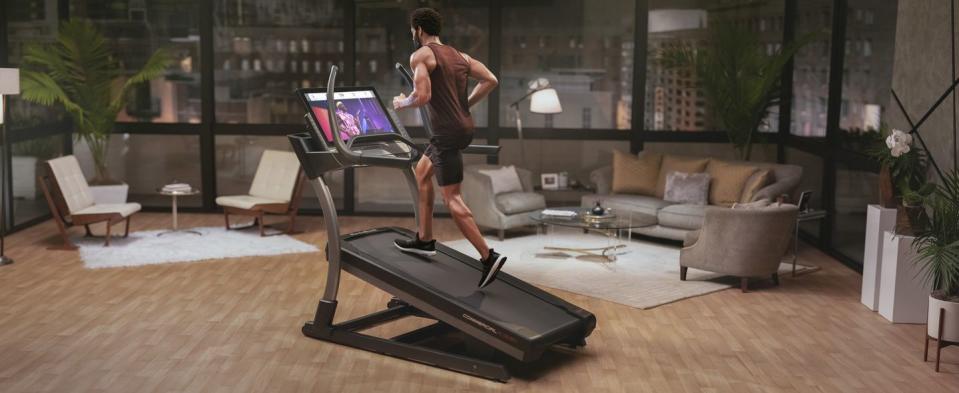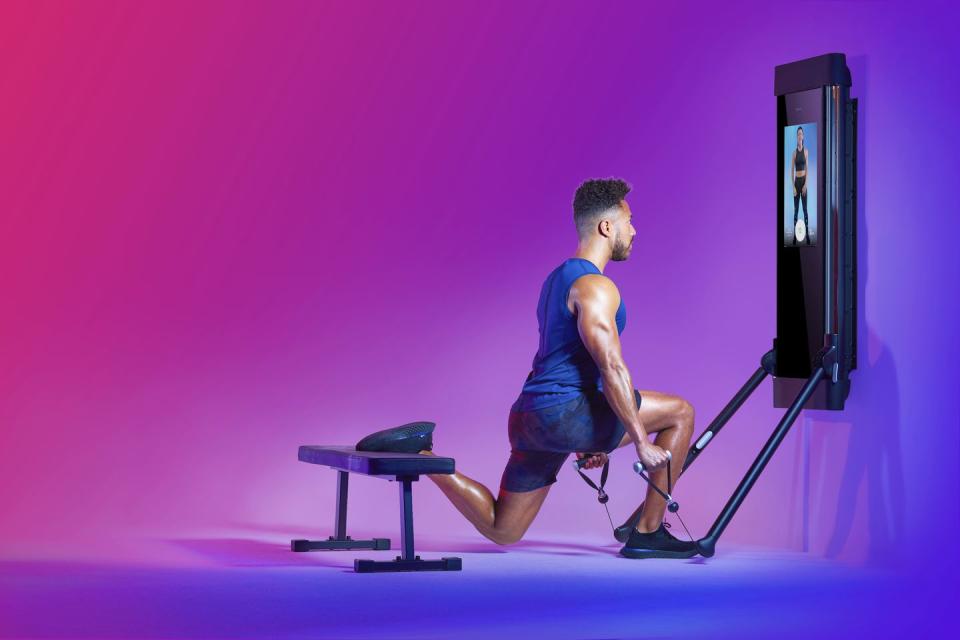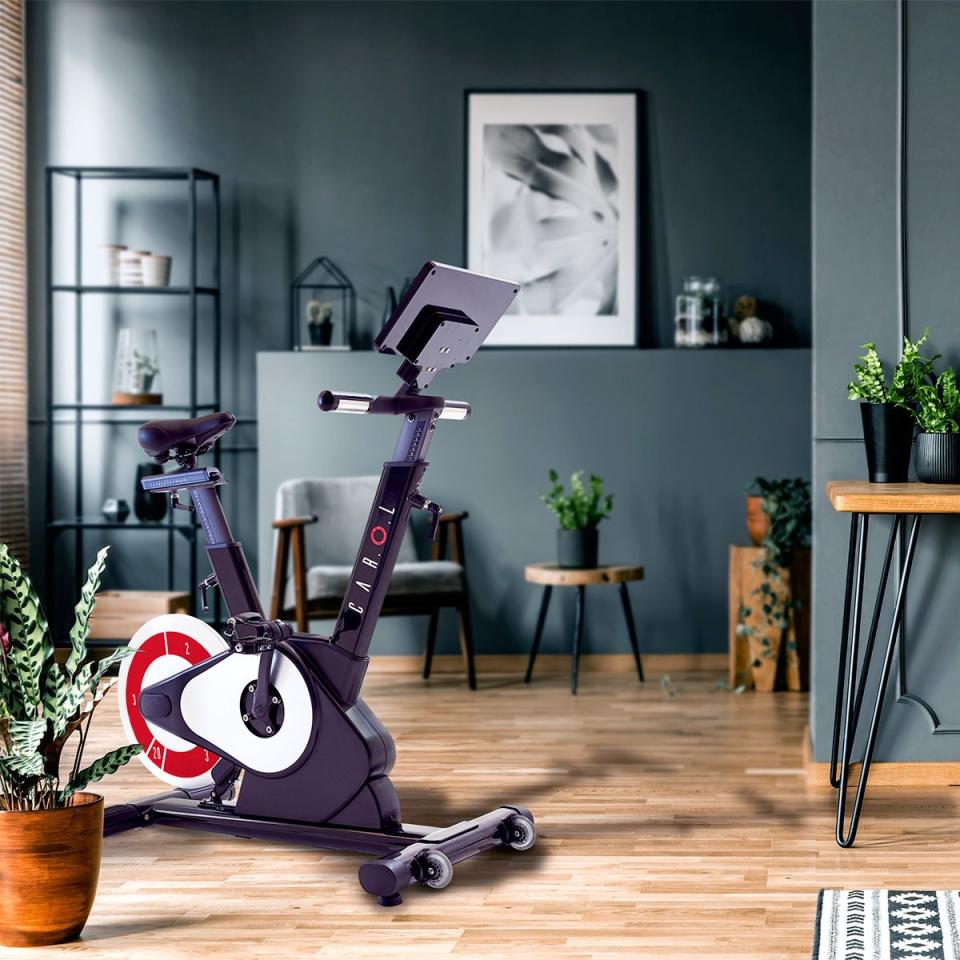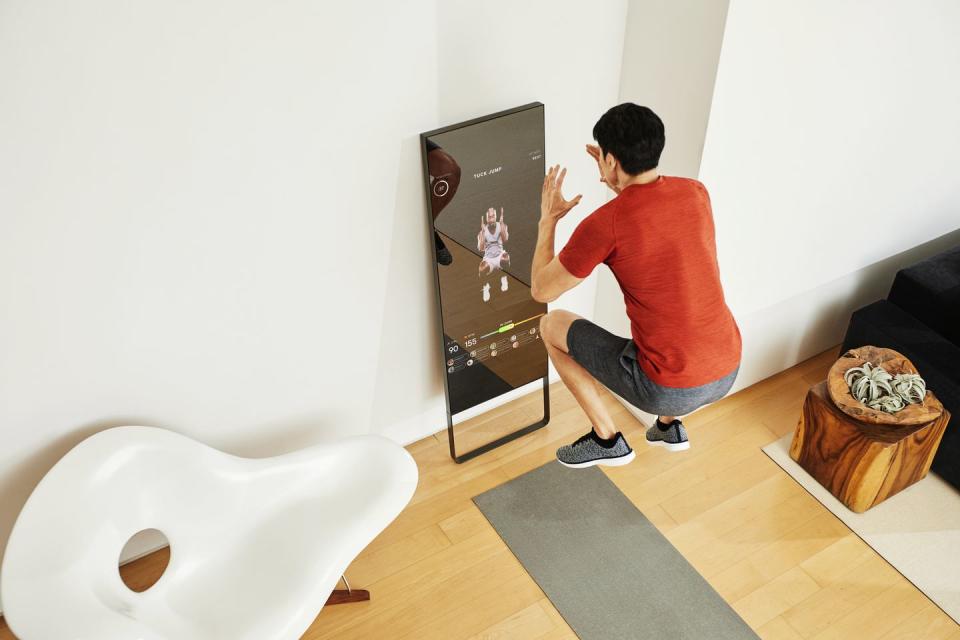Silicon Valley Thinks Artificial Intelligence Can Upgrade Your Workouts

When San Francisco went into COVID-19 lockdown on March 17, the last thing 32-year-old tech entrepreneur Niket Desai had to worry about was staying fit. His regular spot, Barry’s, would be closed indefinitely, but Desai had installed the Tempo Studio, an all-in-one home fitness device designed to turn 30 square feet of your living room into an artificial-
intelligence-powered micro gym.
Tempo is a six-foot-tall weight cabinet (weights included!) kitted out with a 42-inch vertical screen as well as a camera to track movement—a version of Microsoft’s Kinect. While similar devices, like Tonal, offer digital resistance training at home, Tempo is the first one to deploy 3D movement analysis, combined with machine learning and AI to improve your form and curate your workouts.
Its screen streams more than 200 live and on-demand classes, from a ten-minute high-intensity workout to an hour of mobility training, while its motion sensors and AI isolate up to 25 different joints at 30 frames per second. Is your weight too far forward during a squat? Tempo flashes a message onscreen. Rounding your shoulders during a deadlift? Tempo will help you fix it.
“If you strip away the novelty of it, this would be a very weird story about a metal box telling me that I suck at lifting up a piece of metal,” says Desai. “But I was trying to find a cost-effective way to work out at home, and I needed something that was going to motivate me.”
How COVID Drove the Rise of A.I.

While COVID crushed many IRL gyms, it’s sparked interest in home fitness at a moment when there are a growing number of sophisticated machines, like Tonal, Tempo, NordicTrack iFit, and Mirror (which Lululemon is buying for $500 million), that go beyond being connected. They’re smart—able to assess your strength and aerobic ability, track reps, provide feedback, set loads, create workout programs, and, maybe most importantly, keep you stoked to stick with it.
The implications are both obvious and a little unsettling. As a gymgoer who enjoys working out with living, breathing humans in brick-and-Astroturf facilities, I wondered: Who was behind all this bold new tech that claimed it could not only replace trainers but surpass them, ensuring faster, better, more reliable results? Could AI really replicate the thing I’d most come to value at my gym—the people? Was it legit? Was it fun?
How A.I. Gets it Done
After some initial data input and an assessment workout, the Tempo Studio, like other smart devices, starts “learning” your abilities—and deficiencies. Its AI works in three ways: using sensors to analyze your form in order to provide feedback, making specific weight recommendations for each exercise, and directing your programming.
“It all came from this strong value for personal training,” says Moawia Eldeeb, a Tempo cofounder and its CEO. “I wanted people to have access to personal training, and most people can’t afford the best trainers. So I asked, How can I use computer
vision to allow the same level of training for everyone, without any compromises?”
Eldeeb, who spent his early childhood in Egypt and put himself through Colum-bia University’s computer-science program by working as a personal trainer, believes
that getting results means weight training the right way. In 2015, he and fellow Columbia grad—and Tempo cofounder—Josh Augustin developed SmartSpot, a computer-vision-augmented smart screen that they placed in gyms. SmartSpot helps trainers analyze and improve their clients’ form, but it also built a huge database of movement patterns.
By 2019, Eldeeb and his team had collected more than a million exercise moves. They took all the data and used it to develop a program that identifies common errors, while machine learning refines corrections for each user. The program, which Eldeeb claims is even more sophisticated than facial-recognition software, can flag even subtle changes in movement.
“The core of the AI is the 80,000-point cloud of your body that allows us to keep a very close eye on you as you move,” says David Aragon, Tempo’s product lead. “But on the back end, our trainers create each workout from scratch: They program the weight load, the rep sequence—everything to ensure the optimal workout for your fitness goal. The computers are crunching the numbers, but we’re drawing on the knowledge of the experts.”
But Can A.I. Match a Trainer?

The question then becomes: What kind of expertise are these companies bringing to their gear? “These platforms are really exciting, but they are still in their infancy,” says Mark Verstegen, president and founder of EXOS. “You can collect all this data, but then you have to ask, How is it being applied? What is the logic providing value to the end user? How these devices evolve is only as good as the proven, science-based coaching engine behind it.”
Tonal, for example, a wall-mounted device that uses electromagnetic resistance, launched in 2018 as the first big player in the at-home digital-weightlifting space. A team of ten fitness professionals—the coaches you follow onscreen—helped inform its responsive, personalized software. The coaches are well credentialed in a variety of areas, such as fat loss, hypertrophy, and injury prevention. There are one-off workouts as well as monthlong programs, and the AI automatically dials the weight up or down based on your strength output, volume, speed, and overall intensity.
“You can think of each workout as an assembly of Lego blocks,” Ryan Vance, Tonal’s chief content officer, tells me. “You might have 16 workouts in a month program, arranged in splits—day one, day two, day three, day four—then you’ll go through that again. You’ll learn the movements and gain more mass in those areas. The Spotter Mode [part of the AI] reduces the weight if you’re struggling, so you can finish the set. And we’ll note that and adjust for the next time.”
Tonal offers videos of each coach doing a particular move, giving it a vast library of individual exercises. The AI adjusts in real time based on your goals and progress. You can also design your own customized workout, or pick exercises à la carte, using protocols from the trainers. The AI helps, but ultimately what you’re doing is up to you. “It gives us flexibility,” Vance says. “But for the user, it has to feel as organic as possible.”
The Things A.I. Can't Always Do

One area that may not feel particularly organic is working around, or through, an injury. Training is rarely linear; it can be fraught with problems large and small. I recently jacked up my back. Rather than rest and lose a week of training, I did some physical therapy that my coach worked into a light routine and was able to fix the issue fast. It’s hard to imagine a home device so effectively troubleshooting. Tonal, for instance, allows you to manually reduce the weight for any exercise, and it will remember that setting the next time you work out, but you still need input from a real person to know how best to resolve the problem.
One advantage of AI-driven fitness is that machines eliminate the sloppiness that can muck up your analog training. Gains often rely on precision and consistency, but achieving both is easier said than done. Few devices attempt to address this more specifically than the CAR.O.L stationary bike. The acronym stands for cardiovascular optimization logic—a hint at the science under the hood. Two 20-second sprints (in a nine-minute session) deliver the same benefits as a 45-minute jog? The company claims that using the bike for a few weeks will help you lose weight, lower your blood sugar, and reduce metabolic-disease risk by 62 percent. If you believe the hype, CAR.O.L is as close to an exercise pill as we’ve got.
I didn’t believe the hype, so I reached out to CAR.O.L’s founder and CEO, Ratna Singh, who is based in London. Singh says the idea for the bike grew out of a diabetes-
management project she worked on in Abu Dhabi. Knowing how important exercise is for controlling the disease, she says, “I couldn’t figure out why patients weren’t exercising. They have gyms all over, with gold-plated everything!”
Even when they had access to lavish training facilities, Singh concluded, most people weren’t willing to invest the time needed to get results through traditional exercise. It was considered a necessary evil that warranted as little time as possible. Her research led her to the work of Niels Vollaard, Ph.D., an exercise physiologist at the University of Stirling in Scotland, who was studying the minimum amount of exercise required to get the maximum health benefits. Vollaard’s research found that two 20-second all-out sprints (at a personalized resistance level), bracketed by easy cycling, stimulated the same response as much longer exercise bouts, specifically the rapid breakdown of muscle glycogen and the
release of AMPK, a protein that activates molecular pathways responsible for increased insulin sensitivity.
The protocol was so quick and effective, Vollaard named it REHIT: reduced-exertion high-intensity training. It was over so fast, you didn’t even sweat, because your body didn’t have enough time to heat up. But when Singh tried to replicate this using a spin bike, she couldn’t. She needed the right bike, Vollaard told her, one that mimicked what he’d been doing in the lab. “Laboratory HIT and real-world HIT are as different as chalk and cheese,” Singh says. “You simply can’t get the results without this very special piece of equipment.”
That’s a helluva sales pitch, but Singh may be right. The secret sauce in her product is the AI, which calibrates your personal resistance level and then applies it for the duration of the interval. You have to immediately ramp up from zero to max to hit supramaximal power—output so high that you can hold it for only a fraction of a second—in order to attain the desired metabolic response. The problem is, that target shifts upward if you’re doing it correctly and your body is responding. But attempting to regulate this yourself is nearly impossible. Not only wouldn’t you know how much resistance to add, but by the time you were done adjusting your bike, the sprint would be over.
A.I. Is Just Getting Started in Fitness

While some hand-wringing about AI’s role in our future fitness lives may be warranted (I’ll start: Do we really need more screens?), you can already feel the potential of these devices to change the way we work out at home. It reminded me of seeing the first iPhone: It’s not just a new machine; it’s a new platform. Tempo, Tonal, and CAR.O.L each have their unique angle—computer vision, electromagnetic resistance, and supramaximal intervals, respectively. And automating reps, resistance, and intensity can make a huge difference, since those areas are where a lot of our potential progress leaks away. As the software evolves, it will get smarter. Verstegen indicates that high-end training outlets like EXOS may well utilize these home devices as a pipeline for their own programs. “The analogy is Netflix,” he says. “Each platform will have content and access to prescriptions previously only available for elite athletes or personal-training clients.”
How much the devices and the software powering them can personalize feedback is uncertain, and for now humans are still pulling the strings behind the screens. Tempo, for example, provides a trainer concierge service that allows you to interact with a real person, ask questions, and tweak your training. “It’s really all about collaboration,” adds Tonal’s Vance. “Every decision we make on the content side is in lockstep with the exercise science.”
I’m not ready to abandon my gym yet. The camaraderie, the energy, and the nuance and quality my trainers bring to each session simply can’t be matched by a home setup, no matter how smart. But AI is catching up fast. The question isn’t whether this is the future—it absolutely is. The question is where the ceiling will be.
When I talked to Desai in early June, he’d been using Tempo for four months.
“I worked out every single day in April,” he told me. (A favorite: the 15-minute
upper-body double-down.) Better yet, the machine had become a conversation piece in his 600-square-foot apartment. “My friends will come over and ask, ‘Why is your TV sideways?’ When I tell them it’s a gym, they’re obsessed. Then they try it and they’re like, ‘Whoa, that’s wild!’ ”
The Men Behind the Machines
A look at four key A.I. fitness developers.
Tonal
CEO Aly Orady, electrical and computer engineer. AI decreases the resistance so you can finish a move if the device senses you’re struggling. $2,995; $49/month; tonal.com
CAR.O.L
CEO Ratna Singh, former microbiologist. A metabolic workout in nine minutes; AI tries to max out your intensity by calibrating ideal resistance. $2,995; $12/month; carolfitai.com
Tempo
CEO Moawia Eldeeb, trainer and computer scientist. A camera tracks your moves; the device suggests the right weights and offers form fixes as you sweat. $1,995; $39/month; tempo.fit
Mirror
CEO Brynn Putnam, former ballet dancer and Harvard grad. A mirrored smart screen streams live or on-demand workouts and yoga, while AI recommends adjustments. $1,495; $39/month; mirror.co
You Might Also Like

